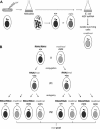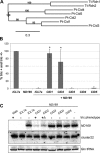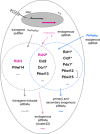A forward genetic screen reveals essential and non-essential RNAi factors in Paramecium tetraurelia
- PMID: 24860163
- PMCID: PMC4066745
- DOI: 10.1093/nar/gku223
A forward genetic screen reveals essential and non-essential RNAi factors in Paramecium tetraurelia
Abstract
In most eukaryotes, small RNA-mediated gene silencing pathways form complex interacting networks. In the ciliate Paramecium tetraurelia, at least two RNA interference (RNAi) mechanisms coexist, involving distinct but overlapping sets of protein factors and producing different types of short interfering RNAs (siRNAs). One is specifically triggered by high-copy transgenes, and the other by feeding cells with double-stranded RNA (dsRNA)-producing bacteria. In this study, we designed a forward genetic screen for mutants deficient in dsRNA-induced silencing, and a powerful method to identify the relevant mutations by whole-genome sequencing. We present a set of 47 mutant alleles for five genes, revealing two previously unknown RNAi factors: a novel Paramecium-specific protein (Pds1) and a Cid1-like nucleotidyl transferase. Analyses of allelic diversity distinguish non-essential and essential genes and suggest that the screen is saturated for non-essential, single-copy genes. We show that non-essential genes are specifically involved in dsRNA-induced RNAi while essential ones are also involved in transgene-induced RNAi. One of the latter, the RNA-dependent RNA polymerase RDR2, is further shown to be required for all known types of siRNAs, as well as for sexual reproduction. These results open the way for the dissection of the genetic complexity, interconnection, mechanisms and natural functions of RNAi pathways in P. tetraurelia.
© The Author(s) 2014. Published by Oxford University Press on behalf of Nucleic Acids Research.
Figures








Similar articles
-
Distinct RNA-dependent RNA polymerases are required for RNAi triggered by double-stranded RNA versus truncated transgenes in Paramecium tetraurelia.Nucleic Acids Res. 2010 Jul;38(12):4092-107. doi: 10.1093/nar/gkq131. Epub 2010 Mar 3. Nucleic Acids Res. 2010. PMID: 20200046 Free PMC article.
-
Primary and secondary siRNA synthesis triggered by RNAs from food bacteria in the ciliate Paramecium tetraurelia.Nucleic Acids Res. 2015 Feb 18;43(3):1818-33. doi: 10.1093/nar/gku1331. Epub 2015 Jan 15. Nucleic Acids Res. 2015. PMID: 25593325 Free PMC article.
-
Functional specialization of Piwi proteins in Paramecium tetraurelia from post-transcriptional gene silencing to genome remodelling.Nucleic Acids Res. 2011 May;39(10):4249-64. doi: 10.1093/nar/gkq1283. Epub 2011 Jan 7. Nucleic Acids Res. 2011. PMID: 21216825 Free PMC article.
-
RNA interference: the molecular immune system.J Mol Histol. 2004 Aug;35(6):545-53. doi: 10.1007/s10735-004-2192-8. J Mol Histol. 2004. PMID: 15614608 Review.
-
A paragenetic perspective on integration of RNA silencing into the epigenome and its role in the biology of higher plants.Cold Spring Harb Symp Quant Biol. 2006;71:481-5. doi: 10.1101/sqb.2006.71.023. Cold Spring Harb Symp Quant Biol. 2006. PMID: 17381330 Review.
Cited by
-
Developmental mRNA clearance by PIWI-bound endo-siRNAs in Paramecium.Cell Rep. 2023 Mar 28;42(3):112213. doi: 10.1016/j.celrep.2023.112213. Epub 2023 Mar 3. Cell Rep. 2023. PMID: 36870062 Free PMC article.
-
Importin-9 and a TPR domain protein MpH drive periodic patterning of ciliary arrays in Tetrahymena.J Cell Biol. 2025 Jun 2;224(6):e202409057. doi: 10.1083/jcb.202409057. Epub 2025 Mar 28. J Cell Biol. 2025. PMID: 40152790
-
Two sets of RNAi components are required for heterochromatin formation in trans triggered by truncated transgenes.Nucleic Acids Res. 2016 Jul 8;44(12):5908-23. doi: 10.1093/nar/gkw267. Epub 2016 Apr 16. Nucleic Acids Res. 2016. PMID: 27085807 Free PMC article.
-
Characterization of the RNA-interference pathway as a tool for reverse genetic analysis in the nascent phototrophic endosymbiosis, Paramecium bursaria.R Soc Open Sci. 2021 Apr 21;8(4):210140. doi: 10.1098/rsos.210140. R Soc Open Sci. 2021. PMID: 33996132 Free PMC article.
-
Exogenous RNAi mechanisms contribute to transcriptome adaptation by phased siRNA clusters in Paramecium.Nucleic Acids Res. 2019 Sep 5;47(15):8036-8049. doi: 10.1093/nar/gkz553. Nucleic Acids Res. 2019. PMID: 31251800 Free PMC article.
References
Publication types
MeSH terms
Substances
LinkOut - more resources
Full Text Sources
Other Literature Sources

